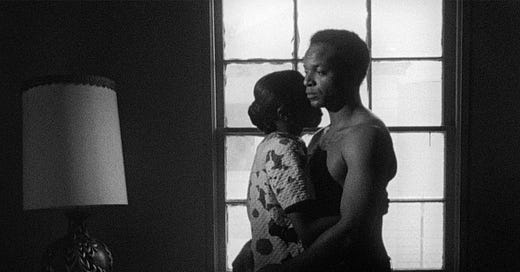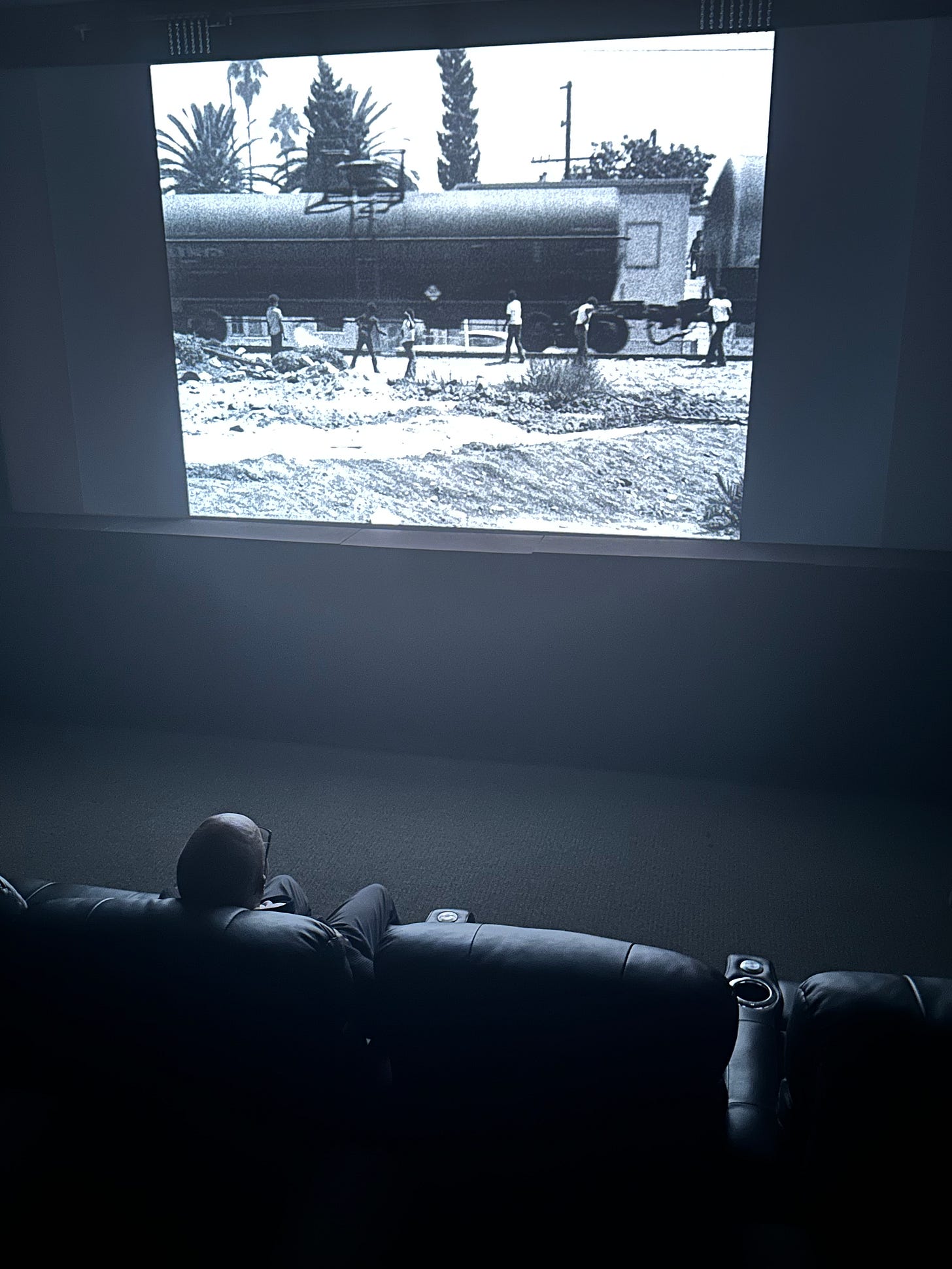When Black Film Archive launched in August 2021, one of my most asked questions was “well… How do I watch “Killer of Sheep?” – the 1978 masterpiece of every day Black poetry from Charles Burnett. Then a student at UCLA, his student thesis became a monument of Black filmmaking’s possibility and has been long unavailable. In the whisper network that followed the film’s release (and underground sharing of film reels), the film’s title alone conjured images of what the art of filmmaking is and could be. The cinematic siren song drew deep imagery of filmmaking as a revolutionary act. Burnett– in his thirties during the film’s completion– found his revolutionary freedom in using his community in frame—the children he would pass on the streets daily, the doldrums of Black life, the drylongso— and in creation— the neighborhood children captured the sound and helped with every part of the filmmaking process when not on screen. As Burnett told me during my Q&A for the LA premiere of “Killer of Sheep” at the Aero on April 16, 2025, “People always said the community couldn’t do this or that with filmmaking so I wanted to put it in their hands.”
Burnett (b. April 13, 1944) was the first of the infamous L.A. Rebellion1 cohort to enter UCLA in 1967. Every poet finds their form and Burnett, who originally wanted to study within the rigidity of practicality, found filmmaking on a whim. “Killer of Sheep” is a lyrical sonnet of a Watts family’s life. Stan (the brilliant Henry G. Sanders) is a slaughterhouse worker who drags the stench of his life’s dissatisfaction home as the pressures and bitterness of masculinity pour out of him and onto his wife (the effective Kaycee Moore), children, and community. Men with gentle hands and hearts are given the burden of a unit’s survival and the distance the burdens offer in this tender outline of life’s cruelties and determination. “Killer of Sheep” gave sight and sound to our beings unlike many films before it and few after. So how does a film like this disappear?
NYC! L.A. Rebellion: Then and Now is playing at Film at Lincoln Center April 25 to May 4. The curated series is a buffet of popular (Burnett’s "To Sleep with Anger") and lesser-seen ("Passing Through" 1977) L.A. Rebellion jewels with recent essential Black works to showcase the intergenerational ties in Black filmmaking and our greater community. I’ve worked with Film at Lincoln Center to provide a discount code for Black Film Archive subscribers. Use promo code BURNETT for $5 off any film in the series.
Originally created as a student thesis and away from the concerns of marketability, Hollywood oversight, or copyright, “Killer of Sheep” found itself in the whims of copyright’s claim from a distinct soundtrack that pulsates from the dynamic range of Black sound and Burnett’s own sonic impulses. Pulling vinyls from his collection as he saw fit, Burnett used the soundtrack as a dialogue between what the screen can capture and what the soul can not say. As an essential element of the film, the soundtrack— with songs from Earth, Wind, & Fire, Paul Robeson, Dinah Washington, and countless others— and the film’s image could never be fully severed.
In 1990, the Library of Congress placed “Killer of Sheep” among the first 50 films in its newly formed National Film Registry for historically significant films. In the early 2000s, the National Society of Film Critics selected it as one of their most essential films of all time. The acclaim it garnered across time took the film from whisper network, unreleased sensation to cinephilic household name without proper release as the film elements began to show their age from wide use. In 2000, Ross Lipman, then the senior film preservationist at UCLA, began the work to restore the film and protect the film’s elements and made a 35mm print from the 16mm negative.2 But before a film can make it from archival holding to our hearts and homes with a commercial release, it must be cleared from copyright. Dennis Doros and Amy Heller, the co-founders of Milestone Films—a repertory3 distributor with a commitment to distribute a dynamic range of film—undertook the complicated and expensive task to secure the music rights and bring the film out theatrically and home video. With UCLA Film & TV Archive’s preservationists Ross Lipman and Jillian Borders leading the restoration, “Killer of Sheep” was commercially released for the first time in fall 2007. The type of music clearances offered at the time had an expiration date, which meant the film’s commercial life was relatively short and was out of print roughly a decade later.

Film Restoration is a frame by frame resurrection of sound, sight, and form. For a revolutionary film like “Killer of Sheep,” whose existence, despite the 2007 release, has remained the diametrically opposed both/and as a film at the margins and cult classic, is now back in the fold. The Criterion Collection, UCLA Film and Television Archive, and Milestone Films underwent an extensive frame-by-frame transformation of sound, image, and clearances to present “Killer of Sheep” as it was intended to be seen. The new 4K director approved restoration was overseen by Ross Lipman and Jillian Borders. I was also proud to serve as a consulting producer for this release and bear witness to the magic unfolding.
With modern film restoration tools, a director can pose new curiosities, edits, and modalities of thought. In the restoration room, Charles, the poet revisiting his earliest full-length prose, posed ideas to how scenes could be shortened, enhanced, and altered. We listened as he offered his considerations for what was, is, and could be. Ultimately, as we all saw the resurrection come back to life, we understood that the film was already made in a divine Black image and our task was to serve that image so it could change the world again and always again. It is often said that Black film has never reached the heights Black literature has; “Killer of Sheep” challenges that thought as Burnett’s tender work and heart provides an everlasting intimacy of our spirit that touches the soul and moves filmmaking forward.
The 4K restoration of “Killer of Sheep” (1978) premieres at New York’s Film Forum tonight, April 18, at 7:50 pm ET with Charles Burnett in person. In Los Angeles, the Laemmle NoHo 7 will open the film on April 25, 2025 with a run. There are also showtimes across the country.
“Killer of Sheep” enters the Criterion Collection on May 27, 2025 in 4K / Blu-Ray.
You can watch many of Charles Burnett’s other films on Black Film Archive here.
As I wrote last newsletter, LA Rebellion is a cohort of Black filmmakers at UCLA who’s commitment to Black image and craft-making pushes beyond the presumption of film’s white, hierarchal, and aesthetic framework.
Killer of Sheep was originally shot on 16mm film cameras.
Repertory films are older films, classic films, that play in art-house cinemas across the country.





Love that you shared the fascinating background to this beautiful film’s restoration. 🙏🏾Seeing it again tonight, with eyes anew!
Lovvved reading about your process & can’t wait for the Criterion release !! Can’t think of a more important American film restoration in recent memory…or a film I’d want to watch on repeat more 🔂🔂🔂